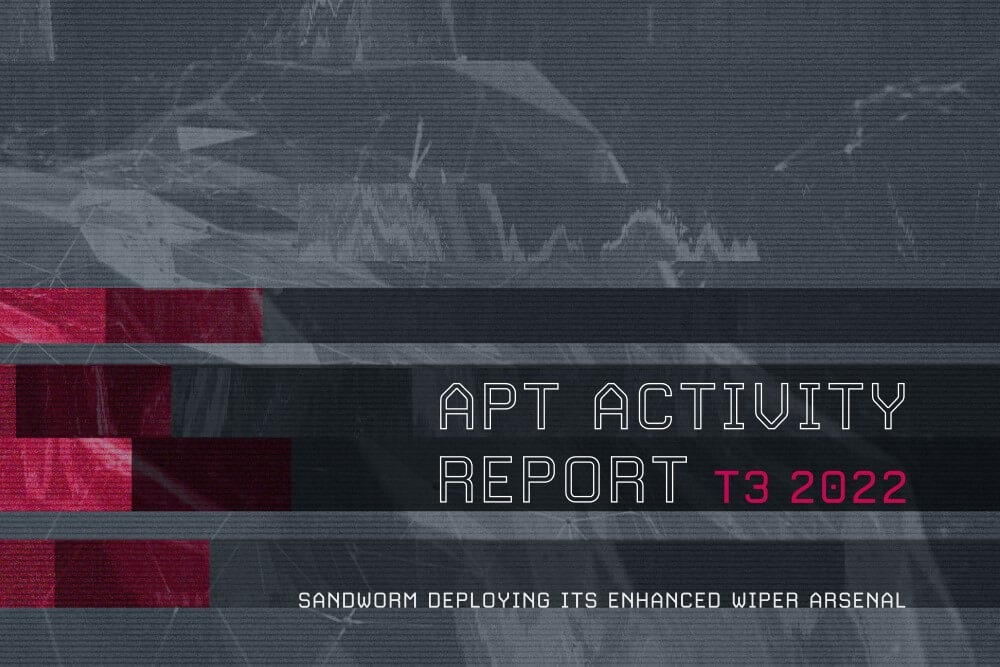ESET Research today released its latest APT Activity Report, which summarises discoveries about select advanced persistent threat (APT) groups that were observed, investigated, and analysed by ESET researchers between September and the end of December (T3) 2022. During this period, Russia-aligned APT groups continued to be particularly involved in operations targeting Ukraine, deploying destructive wipers and ransomware. Goblin Panda, a China-aligned group, started to duplicate Mustang Panda’s interest in European countries. Iran-aligned groups continued to operate at a high volume, too.
In Ukraine, ESET detected the infamous Sandworm group using a previously unknown wiper against an energy sector company. Nation-state or state-sponsored actors usually operate APT groups; the described attack happened in October during the same period when Russian armed forces began launching missile strikes targeting energy infrastructure. While ESET is not able to show that those events were coordinated, it suggests that Sandworm and the Russian military have related objectives.
ESET has named the latest wiper, from a series of previously discovered wipers, NikoWiper. This wiper was used against a company in the energy sector in Ukraine in October 2022. NikoWiper is based on SDelete, a command line utility from Microsoft that is used for securely deleting files.
In addition to data-wiping malware, ESET discovered Sandworm attacks using ransomware as a wiper. In those attacks, although ransomware was used, the final objective was the same as for the wipers: data destruction. Unlike traditional ransomware attacks, the Sandworm operators do not intend to provide a decryption key.
In October 2022, ESET detected Prestige ransomware being deployed against logistics companies in Ukraine and Poland. And in November 2022, ESET discovered new ransomware in Ukraine written in .NET that we named RansomBoggs. ESET Research publicly reported this campaign on its Twitter account. Along with Sandworm, other Russian APT groups such as Callisto and Gamaredon have continued their spearphishing campaigns against Ukraine to steal credentials and install implants.
ESET researchers also detected a MirrorFace spearphishing campaign targeting political entities in Japan and noticed a gradual change in the targeting of some China-aligned groups – Goblin Panda started to duplicate Mustang Panda’s interest in European countries. Last November, ESET discovered a new Goblin Panda backdoor, which we named TurboSlate, in a government organisation in the European Union. Mustang Panda has also continued to target European organisations. Last September, we detected a Korplug loader used by Mustang Panda at an organisation in Switzerland’s energy and engineering sector.
Iran-aligned groups continued their attacks, too – besides Israeli companies, POLONIUM also started targeting the foreign subsidiaries of Israeli companies, and MuddyWater probably compromised a managed security service provider.
North Korea-aligned groups used old exploits to compromise cryptocurrency firms and exchanges in various parts of the world. Interestingly, Konni has expanded the repertoire of languages it uses in its decoy documents to include English, which means it might not be aiming at its usual Russian and South Korean targets.
For more technical information, check the full “ESET APT Activity Report” on WeLiveSecurity. Make sure to follow ESET Research on Twitter for the latest news from ESET Research.
ESET APT Activity Reports contain only a fraction of the cybersecurity intelligence data provided to ESET private APT report customers. ESET prepares in-depth technical reports and frequent activity updates detailing activities of specific APT groups in the form of ESET APT Reports PREMIUM to help organisations tasked with protecting citizens, critical national infrastructure, and high-value assets from criminal and nation-state-directed cyberattacks. More information about ESET APT Reports PREMIUM that deliver high-quality, strategic, actionable, and tactical cybersecurity threat intelligence is available on the ESET Threat Intelligence page.










Discussion about this post